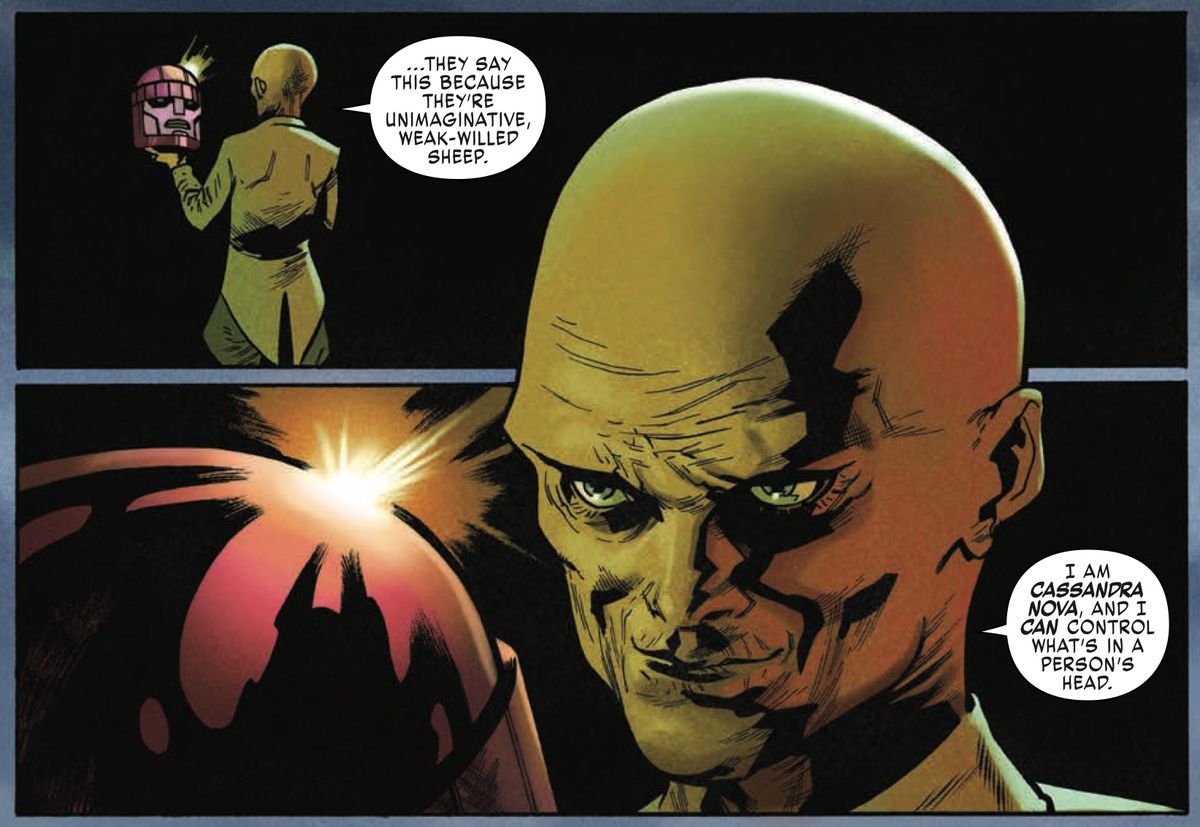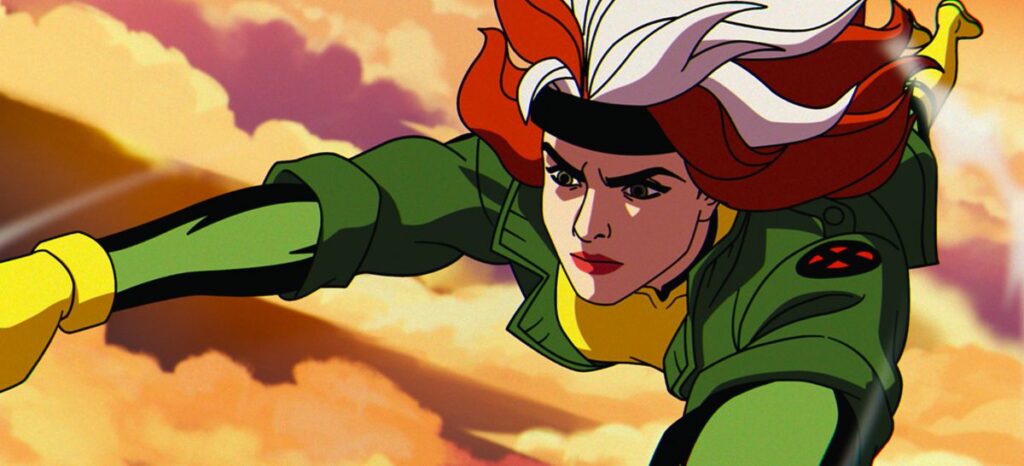In the first half of its first season, X-Men ’97 has played it a little safe. That’s not to say things haven’t been rather fun, as the show has put its own spin on the Inferno and Lifedeath storylines, on Magneto inheriting leadership of the X-Men, and on the birth of Nathan Summers — all pillars of X-Men continuity or beloved greatest-hit stories of the 1980s and 1990s.
But in its fifth episode, X-Men ’97 does something X-Men: The Animated Series never could have. What’s more, the show did it emphatically, boldly, and downright thrillingly: a half-hour workshop on what you get when the X-Men brands of soap opera, sci-fi action, and philosophy of the Other come together just right.
You get one of the best spectacles superhero comics can offer.
[Ed. note: This piece contains spoilers for “Remember It,” the fifth episode of X-Men ’97.]
Image: Marvel Animation
This week on X-Men, the X-Men went to Genosha and they watched it fall.
What’s the deal with Genosha?
Genosha is an island nation for mutants, first created by Chris Claremont and Rick Leonardi in 1988. If you’ve read any X-Men comics since 2019, Genosha probably sounds a lot like Krakoa, the island nation for mutants introduced in 2019’s House of X/Powers of X series. And writer Beau DeMayo and director Emi Yonemura definitely play with that resonance in “Remember It.”
Their version of Genosha is ruled by a “council” that includes Magneto, Sebastian Shaw, Emma Frost, and Nightcrawler, as a religious advisor. Moira MacTaggert is there too, with Exodus in cameo, as the X-Men attend a “gala” filled with mutant fashion and music — all Krakoan hallmarks.
But the episode’s silent cameos are loaded with post-1990s mutant students like Glob Herman, Pixie, and Nature Girl, and they’re an early warning sign that “Remember It” is merely weaving Krakoan packaging around the island of Genosha. Because while the story of Krakoa (even as it comes to an end) is of a mutant paradise, the story of Genosha is of a mutant genocide.
Claremont and Leonardi’s Genosha began its editorial existence as a totalitarian state that oppressed all mutants within its borders, intended as a direct metaphor for South African apartheid. But by the late 1990s, the original Genoshan government had been overthrown and replaced with a Magneto-led mutant state. That is, until 2001, when, in the second issue of Grant Morrison’s New X-Men, “E Is for Extinction (Part 2),” an anti-mutant supervillain massacred all 16 million mutants on the island in a day using a kaiju-sized, bug-shaped Sentinel robot and fleet. Which is exactly what happens in X-Men ’97’s “Remember It.”
Who destroyed Genosha?

Image: Tom Taylor, Mahmud Asrar/Marvel Comics
X-Men ’97 leaves this question conspicuously dangling, at least in this episode. When Cable arrives from the future with a dire but vague warning — as he does here to Madelyne Pryor — it usually indicates that the villain Apocalypse is to blame. But kaiju-sized Sentinels aren’t really Apocalypse’s style.
DeMayo and Yonemura were likely very aware that fingers would also point at the villain who destroyed Genosha in the comics: Cassandra Nova, Professor Xavier’s evil double. Needless to say, with the Professor dead, it’s a great time for his dark mirror to show up and give everyone a complicated set of feelings about it. And with Jean and Madelyne seeming to receive some kind of psychic attack during Genosha’s demise, the evidence is mounting.
But the really exciting thing about “Remember It” is that we’re even talking about X-Men ’97, a show about replicating nostalgia for the X-Men of the 1990s, and Cassandra Nova, the quintessential post-’90s X-Men supervillain, in the same breath.
If Cassandra Nova is on the table, anything could be.
X-Men ’97 is X-panding beyond its mandate

Image: Frank Quitely/Marvel Comics
To X-Men scholars, the 1990s are infamously famous for being a transitional time. From 1975 to 1990, the characters were essentially the pet project of Chris Claremont, the first writer to truly make the title a success. With his departure, the X-Men titles were produced by a more traditional rotating succession of writer/artist teams, producing a lot of high highs and low lows as those creators put their own spin on the formula Claremont had established.
When you talk about the “’90s era of X-Men,” with which X-Men: The Animated Series is so closely associated, there’s a specific point at which the period is considered to have been over, full stop: not New Year’s Eve 1999, but at the moment that Grant Morrison and Frank Quitely published their first issue of New X-Men in 2001.
Morrison was the first post-Claremont writer who truly iterated on the concept of the X-Men, rather than simply replicating. The X-Men went fully postmodern, with Morrison as interested in making a superhero comic as in playing with the idea of a newly emerging culture defined by being oppressed and having weird powers. Ideas of mutant fashion, art, and social commentary — of mutant teens that found it edgy to dress like anti-mutant racists and to piss off their teachers by wearing “Magneto was right” T-shirts — define the Morrison era.
In Claremont’s X-Men, mutant characters whose powers aren’t so much dangerous as they are disfiguring or disquieting were relegated to the little-seen sewer-dwelling community of the Morlocks. In Morrison’s X-Men, they were a large part of the Xavier school student body — “Remember It” prominently features Morrison and Quitely’s Glob Herman, whose mutation is that he’s a skeleton and organs enclosed in a regenerating mass of flammable, pink, translucent paraffin wax. They also introduced the concept of “secondary mutation,” to transform existing mutant characters, giving Beast a catlike face and digitigrade legs.
Morrison’s swerve was so reactionary to ’90s X-Men — Beast, a monster; Cyclops marrying Emma Frost; Jean welcoming the power of the Phoenix with open arms; Genosha massacred — that it’s no surprise that the folks behind X-Men ’97 would be tempted to apply its events to this earlier, more innocent version of the characters. It wouldn’t even be the first time.
There’s been more than 25 years of new X-Men stories since X-Men: The Animated Series went off the air. It’d be unreasonable to expect the folks behind X-Men ’97 not to look to those decades for inspiration. “Remember It,” far and away the best episode of the show so far, is a very compelling reason to be excited about that.

